Fun & Games in Kyrgyzstan
“On arrival, we finally struggled through Security, collected our goody bags (Kyrgyz flag, orange baseball cap, four glowing sticks to wave, programme of events), and took our seats in the stadium. We had superb seats near the front, just behind the press corps. We were then treated to 150 minutes of spectacular light-shows, gymnastics on horseback, dance routines, an enactment of the Kyrgyz racial foundation myth, incomprehensible speeches from national panjandra, and a seemingly endless procession of the nations, parading behind their flags, from the massive teams of the Russians and Chinese to the single tiny woman wrestler and banner-bearer from Singapore. Also, two Rastafarians from Jamaica, half a dozen kilted Scots and a lone Australian.”—By Michael House
Polemicist on Holiday
By Michael House, FRGS
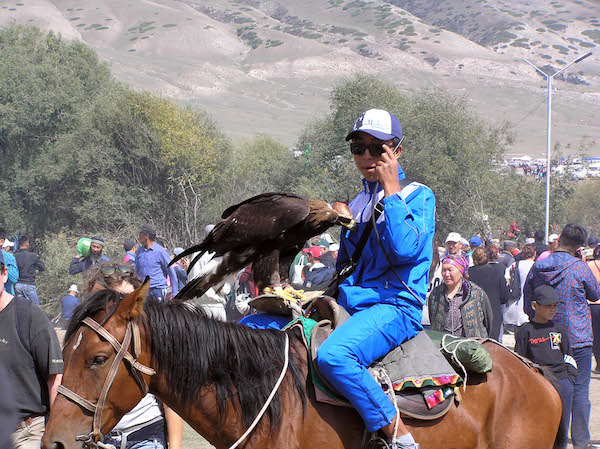
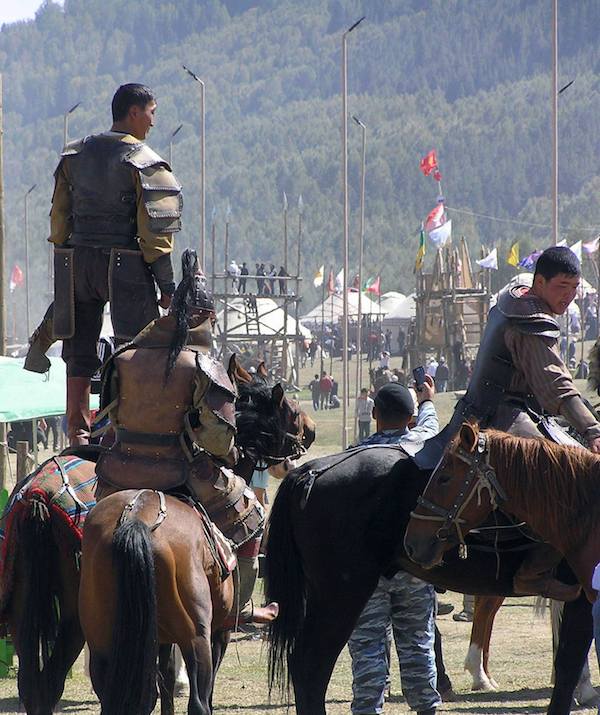
KINGS SUTTON England—(Weekly Hubris)—December 2018— “You’re going where? Kurdistan?”
“No! Kyrgyzstan!”
Kyrgyzstan. The secret jewel of Central Asia. Major artery of the Silk Route. Home of the Mountains of Heaven, hunting eagles, upland lakes, alpine meadows, yaks and yurts, nomad herders, onion-domed Russian churches, shy whistling marmots, and acrobats on horseback.
But most of all, on this trip, venue of the World Nomad Games. When I first heard of the Games, I thought of a few blokes from the former Russian Stans getting together in a field for a bit of wrestling and archery. But they are a big deal. The spectacular opening ceremony in a purpose-built hippodrome was attended by Dictator Erdogan of Turkey, and Orban, the racist Prime Minister of Hungary. Seventy-seven countries were represented in the procession, with teams comprising 3,000 athletes. It wasn’t necessary to be a bona fide nomad to compete, only to participate in nomadic sports, a definition very widely drawn. More of this anon.
A few facts about the country. Kyrgyzstan is a landlocked, mountainous country, a former province of the Soviet Union. It became independent in 1991. It is surrounded by China to the east, Kazakhstan to the north, Uzbekistan to the west, and Tajikistan to the south. Ninety percent of the country lies above 1,500 metres/4,921.26 feet. Different ranges of the Tien Shan (Mountains of Heaven) dominate the landscape, together with outliers of the Pamirs. The average elevation is 2,750 metres/9,022.31 feet. Eternal snows cover many peaks. The longest of its thousands of glaciers measures 62 kilometres/38.5 miles, one of the world’s longest. Four percent of the country is glacier. The highest peak stands at 7,439 metres/24,406 feet.
Kyrgyzstan is about the size of Nebraska or England, Scotland and Wales, with a population of around four million. About 70 percent of the population is Kyrgyz, originally Turkic nomads from Siberia. The rest are mainly Uzbek (about 15 percent) or Russian (around 10 percent). The Kyrgyz, mainly found in the north, are predominantly moderate Sunni Muslims, whose religion overlies a core of shamanism. Until the Soviet era, they were predominantly nomadic pastoralists. The Uzbeks, dominant in the south, are harder-line Muslims, mainly settled farmers.
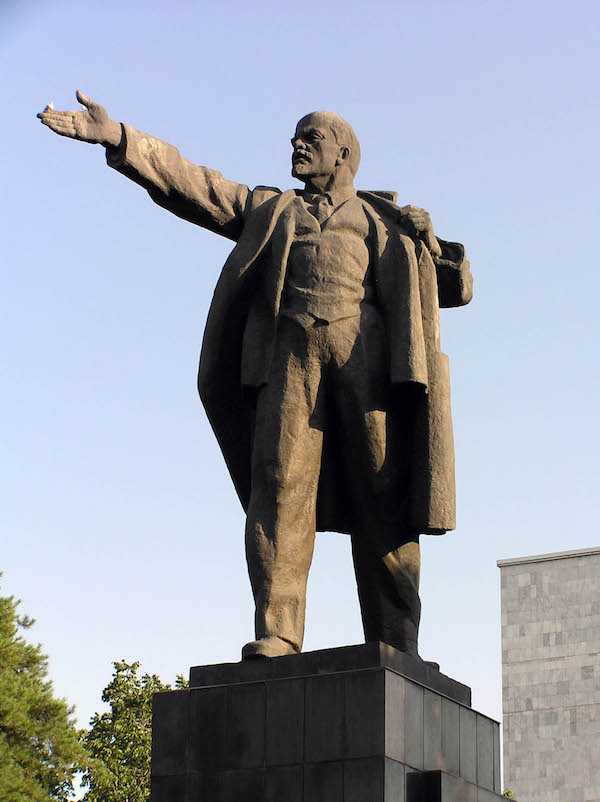
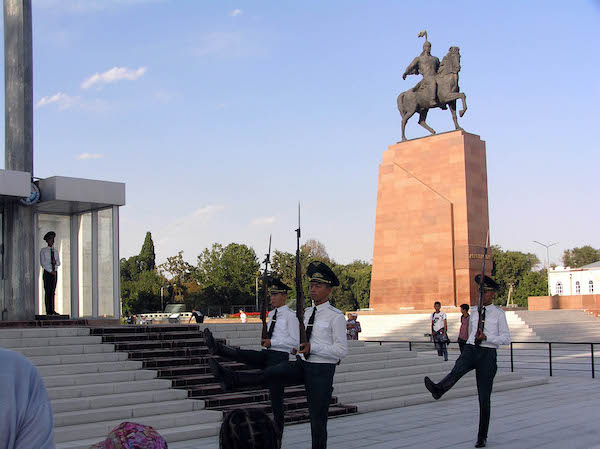
Day 1: Flight to Istanbul, followed by an overnight flight to the capital, Bishkek. Day ends somewhere over eastern Turkey.
Day 2: Bishkek is a low-key, well laid out Russian city, with pleasant wide boulevards and plenty of greenery. Statues abound. Lenin towers over the State Historical Museum. In Ala-Too Square, we watch the hourly changing of the guard beneath the 45-metre/148 foot-tall national flagpole. The slow-motion goose-step of the two relieving soldiers looks very difficult. Then they have to stand for an hour without moving while small boys make faces at them. We visit Osh market, holding our noses through the meat section, where nothing is left to the imagination. Then, back to the Golden Tulip hotel for, it is to be hoped, the first proper sleep in 36 hours. Couldn’t sleep. Watched CNN. Saw Trump ascend the steps of a plane, a piece of toilet tissue stuck on his foot. Marveled at the beauty of the metaphor: what would a piece of lavatory paper be attached to but a fat turd?
Day 3: Ninety-minute drive through lush farmland takes us to the Burana Tower, the main architectural site of northern Kyrgyzstan. Imagine the Leaning Tower of Pisa, only vertical. It is the minaret of a long-lost mosque in a long-lost Silk Route city called Balasagun, which flourished from the 10th century; finally abandoned in the 15th. Time and earthquakes have drastically shrunk it to 24 metres/79 feet, just over half of its original size. It is an elegant structure, the banded honey-coloured brick tapering gently to the viewing platform at the top.
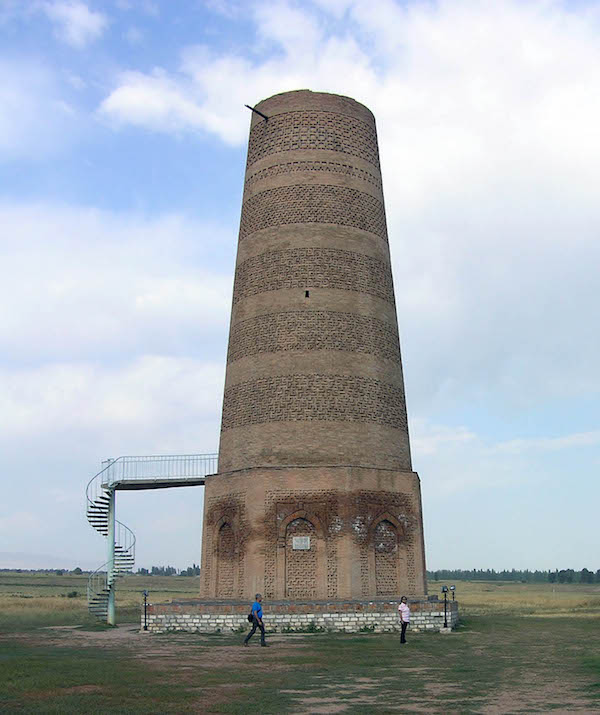
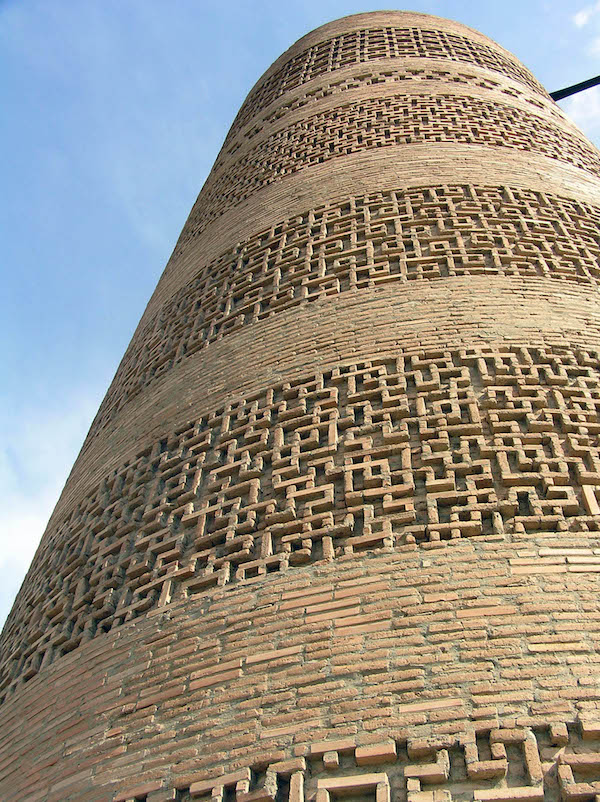
Onward to the small market town of Kochkur, for lunch at a charming guest house. I am not a foodie—food is fuel to me—so I will not dilate upon Kyrgyz cuisine. But it was very tasty. Then, a fascinating lesson in making felt and creating designs on it. Felt is made by beating wool with sticks, pouring hot water on it, rolling it into a cylinder within an existing piece of felt and rolling it backwards and forwards with your feet. The two ladies involved turned that into a sort of dance.
I was especially attracted to the shydrak rug method, or appliqué. Take two pieces of felt of the same size, one of white wool, one of grey, each with a brown felt backing panel sewn on. On each piece, draw an identical simple design in chalk, say a stylised goat. Cut the goat out of each piece. Swap them over, so you have a white goat on a grey background and a grey goat on a white background. Stitch the goats to the backing panel, and you have two simple, charming rugs. We bought a pair of goats, which now sit on a coffer in the hallway of our London flat.
We then visited a women’s co-op, where all sorts of beautiful textiles were being made and sold. I bought an exquisite old embroidered panel. They are, or were, made by grandmothers as part of the dowries of their granddaughters when they marry. The maker had sewn her name at the bottom.
After a stunning drive through the mountains, where we saw herds of yak grazing, we arrived at a yurt camp by an alpine lake. We ate freshly-caught fish that night.
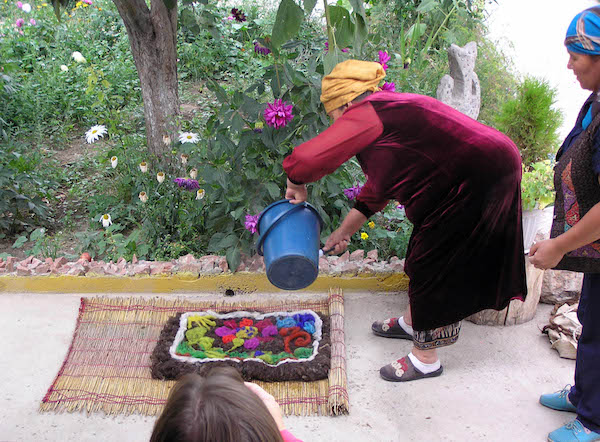
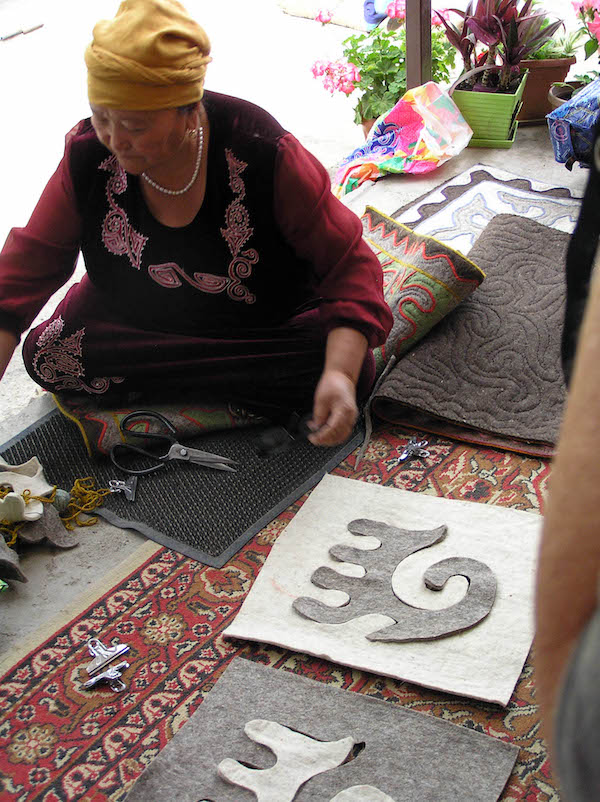
Day 4: A gentle stroll into the hills to look at ancient petroglyphs, mainly goats, incised on rocks. These may be seen throughout the country. In the afternoon, those of an equestrian disposition went riding. Later, we witnessed a display of the horsemanship for which the Kyrgyz are celebrated. The most impressive feat was that of horsemen, at full gallop, stretching down and picking currency notes off the ground . . . without falling off.
We were also treated to a rather distasteful spectacle, kok boro, which is a species of polo played with the headless corpse of a goat. I’ve seen this in northern Pakistan, where they call it bushkazi. Dead animals should be treated with dignity, not used for sport. It is violent, akin to wrestling on horseback; it has claims to be the national sport; and it is a test of manhood which defines status in the community. Ours was a “friendly” game, but when rival communities perform, anything goes except shooting and stabbing.
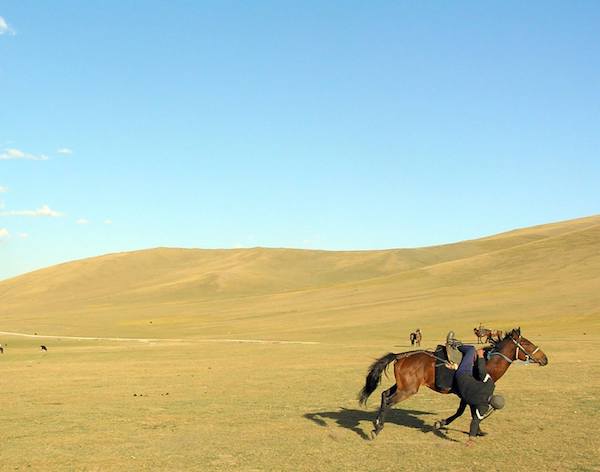
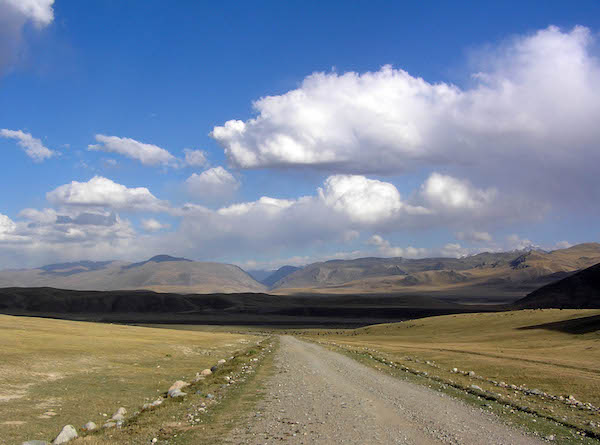
Day 5: Yurts are very warm and comfortable. I was awakened by cows wandering through the camp, calling to each other. We were soon on the road again, heading south. We stopped at a nomad camp to drink kumiss, which is mildly alcoholic fermented mare’s milk, popular throughout Central Asia. I sipped politely, but it tasted no better than it did in Mongolia twelve years ago. Horrible stuff, though supposedly very good for you. Tolstoy, Chekhov, and Gorky are said to have taken the kumiss cure at Russian sanitoria in the 19th century.
We continued south, stopping for half an hour at Kajerty, just another of the many spectacular waterfalls this country is blessed with. Then on towards Tash Rabat, one of the great architectural sites of Central Asia. We stopped to photograph, against the westering sun, a Kyrgyz cemetery that would have been astonishing were the country not festooned with them. By the roadside were rows of little houses in every possible style from Scottish baronial to Chinese pagoda, the last resting place of generations of Kyrgyz.
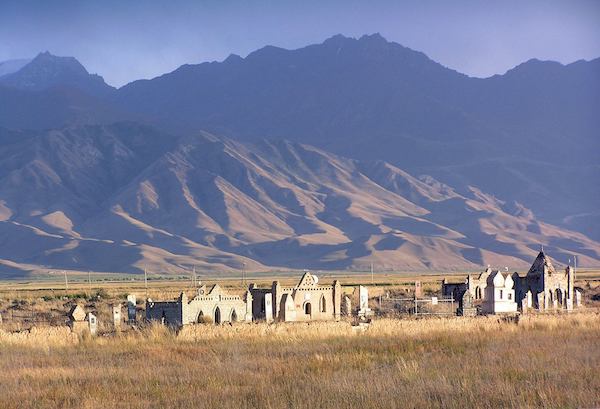
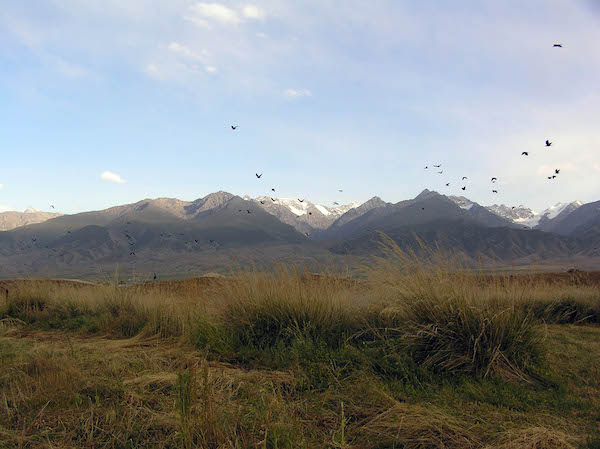
One more stop before reaching our destination was Koshoy Korgon, an early medieval fortress of mud-brick, covering a large area and with surviving walls 2.3 metres/598 feet high.
Tash Rabat is a perfectly preserved 15th-century caravanserai, perhaps the finest Silk Route monument surviving. Here, travellers and merchants found bed and board in a remote hidden valley off the main Silk Road, 11,500 feet above sea level, safe from the depredations of bandits and wolves. Like the Tardis, it looks very small from the outside, but it is substantial inside. It is nearly 37 metres/120 feet long, the domed central hallway surrounded by about 30 dank, cold cells. It is a very atmospheric place, set in the prettiest of valleys, beside a bubbling stream, a highlight of the trip.
That night we stayed in a yurt camp further down the valley. It was bitterly cold, the domestic offices primitive in the extreme, but the dinner delicious.
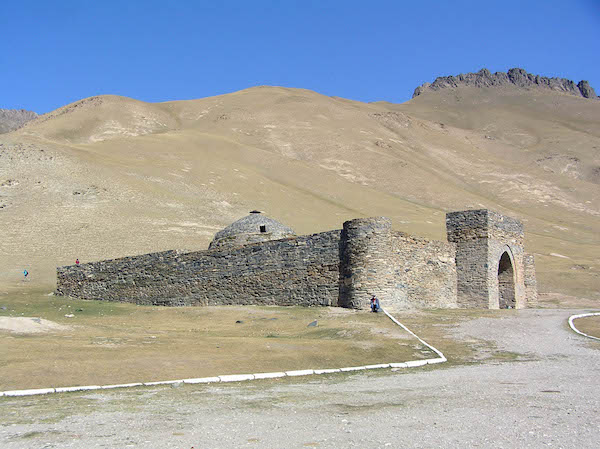
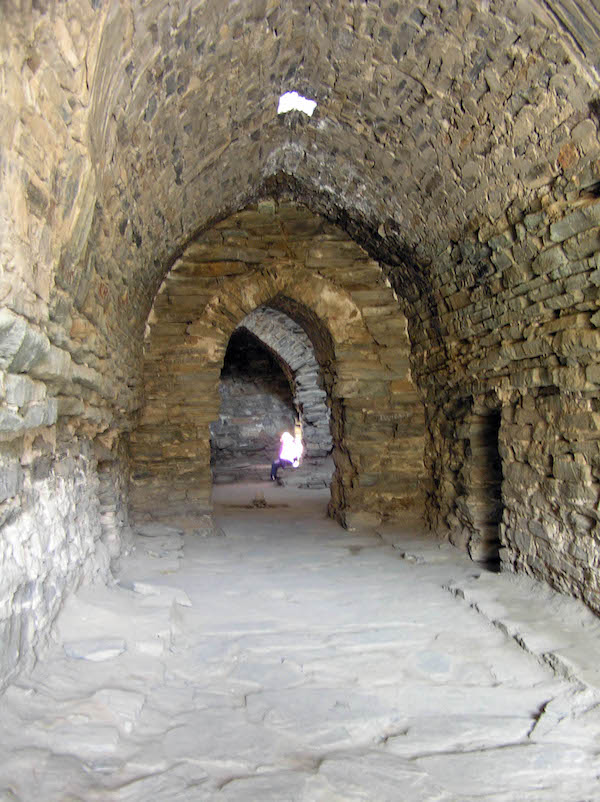
Day 5: A visit to the caravanserai. Otherwise, a gentle day strolling about in the alpine meadows. Our guide promised us marmots, which are said to tease the local dogs by whistling and then retreating into their burrows. But sadly, they stayed below ground today.
Day 6: Reluctantly left the lovely valley of Tash Rabat. Picnic lunch in a woody glade by a little river. Onward and upward to what is termed Wild Camp—nothing there but tiny tents, a dug latrine with a sentry box over it, and a mess tent. Being claustrophobic, I couldn’t bear to sleep in our miniscule tent, so I put on every item of clothing I had and tried to sleep in the mess tent. I may have dropped off to sleep occasionally. I emerged to snow, a temperature of minus seven C.; with wind-chill, minus 15.
The reason we were in this wilderness was because it was the starting point for a long hike over a high pass at 4,100 metres (13,450 feet, nearly half-way up Everest). By way of comparison, the highest point in the UK is Ben Nevis, 1,341 metres/4,400 feet.)
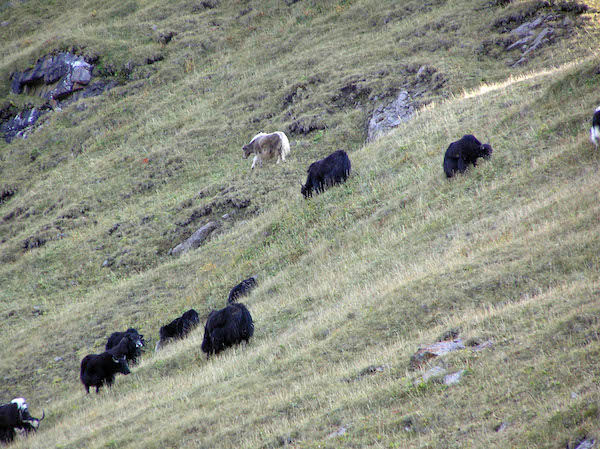
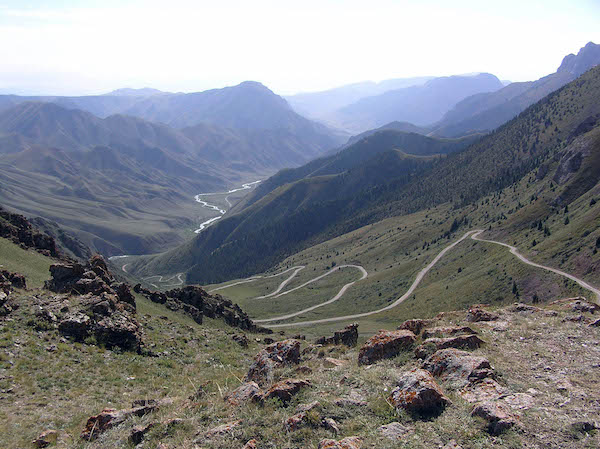
Day 7: The Ton Pirival Pass is only for the tough and fit. Being tough but not fit (herniated disc), I had to pass on the Pass. So, with others in the party, I drove in a minibus to our next yurt camp on the south coast of Lake Issyk Kul. At dinner, I listened, fuming, as the walkers described the magnificent scenery en route to the top.
Day 8: Issyk Kul (Warm Lake) is the second-largest alpine lake in the world, beaten only by Lake Titicaca in South America. It stands at 1,600 metres/5,250 feet. Despite its height, it has a warm microclimate, much appreciated in a country where winter temperatures hit minus 30 C. Issyk Kul hits the record books again as the fifth deepest lake in the world (668 metres/2,200 feet.) Over one hundred water courses flow into it, and its main source is snow-melt from the Tien Shan mountains.
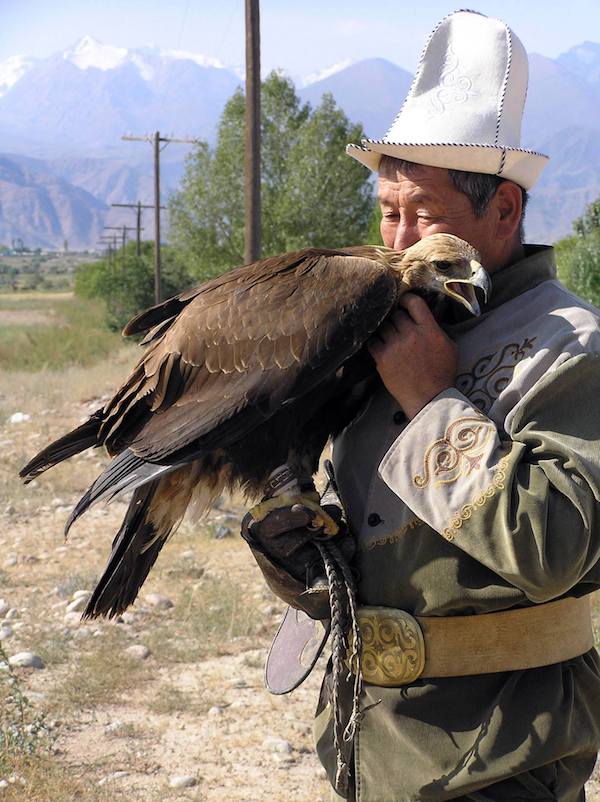
Our yurt camp was sheer luxury, a yurt for every couple—no more snoring males to share with—and the first shower in 5 days. We walked to the beach on the southern shore of the lake, and one madcap member of our group went for a paddle. My spouse, Diane, and I had a go on the swings. Great food as in all the yurt camps, then a sound sleep in a warm bed.
Day 9: We drove east along the south coast of the lake towards the town of Karakol. En route, we were treated to a display of hunting with eagles. The hunter had brought with him a live rabbit to use as bait, but we vetoed that. So, he used a dummy. Afterwards, everyone posed with the eagle on their arm. They are very heavy birds.
Karakol is a charming, low-key town, though it is the focal point of the state’s infant tourist industry, perfectly positioned for visits to the lake and the mountains. It gives you an idea of what pre-Soviet small towns must have been like. It is set in a Russian grid pattern, but with none of the grandiose boulevards and flamboyant statuary of Bishkek, although the ubiquitous Lenin statue is present. The streets, lined with poplars, are dotted with old, wooden gingerbread houses, like something out of a 19th-century fairy tale. It has an anachronistic feel with a taste of a frontier town.
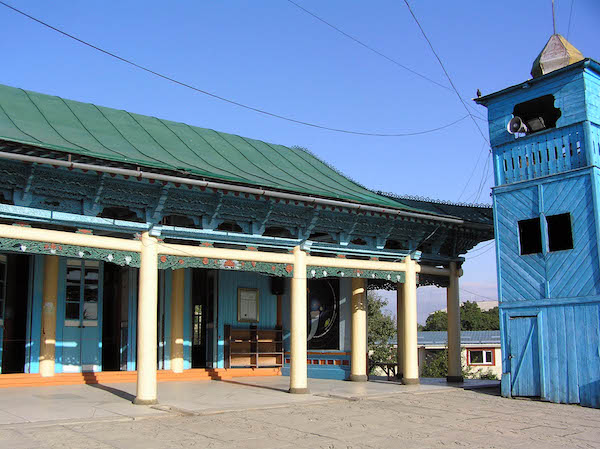
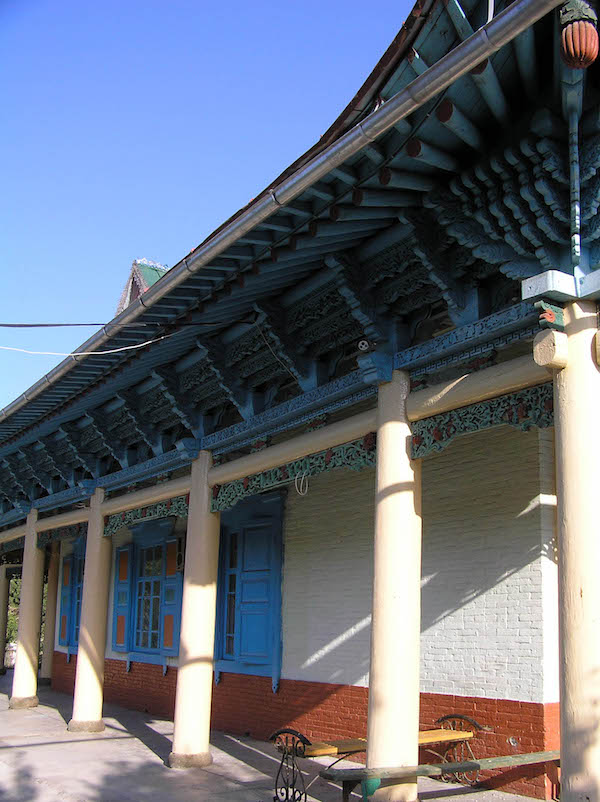
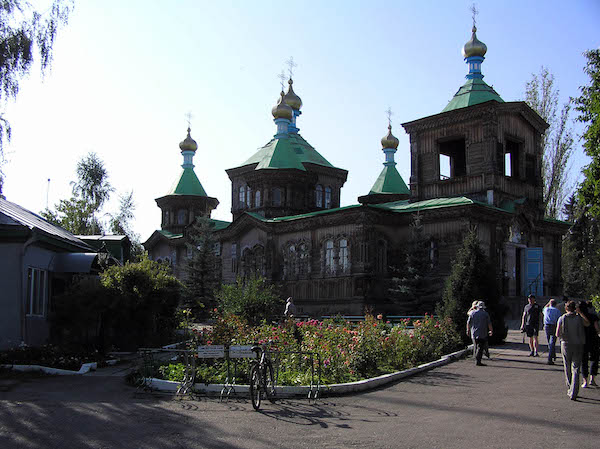
Day 10: Morning of sight-seeing in Karakol. We visited the Dungan mosque. The Dungans were Chinese Muslims who fled China as refugees in the 19th century. Their mosque could easily be mistaken for a Buddhist temple. It was built in the first decade of the 20th century, and, like the Potala palace in Lhasa, entirely without nails. It has a low minaret in powder blue and verandas on either side of the entrance. There is a good deal of Buddhist iconography incorporated into the decoration.
Next up, the Holy Trinity Orthodox Cathedral. Built entirely of wood on a stone foundation and completed in 1890, it was used by the Soviets as a dance hall in the 1930s and re-consecrated in 1991, its five green onion domes restored to their former glory. It would not be out of place in Red Square.
Then on to a nearby village for, to me, one of the highlights of the trip, a visit to the Przhevalsky memorial park and museum. Nikolay Mikhaylovich Przhevalsky was one of the great explorers of Central Asia in the late 19th century and an enthusiastic player of the Great Game, the titanic struggle between Russia and the British to control and annex High Asia. Like many of his kind, he was obsessed with wanting to be the first European to enter the holy city of Lhasa since the Abbe Huc in the 1840s, but he never made it. Although he was a distinguished geographer and biologist, his main purpose in his four great expeditions was the gathering of intelligence to inform Russian expansionism. His main legacy is Przhevalsky’s horse, a short, tough Mongolian quadruped, a rather moth-eaten stuffed example of which stands in the museum.
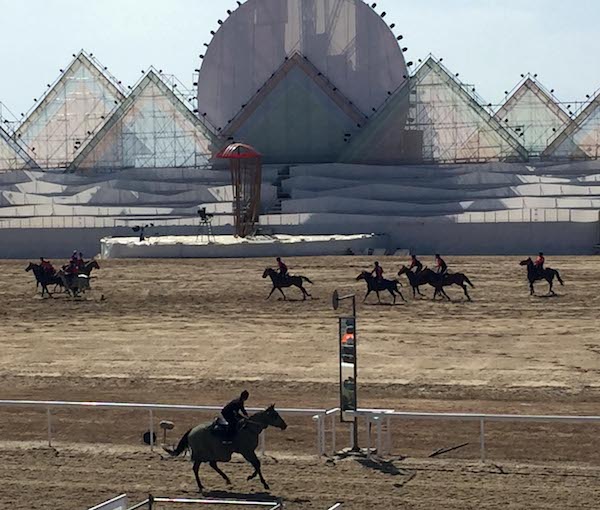
An avenue lined with native trees and bright flower beds leads to the great man’s grave and monument. Twenty-one huge slabs of rock make a miniature mountain, topped by a spread-winged eagle. It is a peaceful and atmospheric place. The museum tour was curated by a splendid old babushka whose hero-worship was quite touching. We saw the great man’s books, letters, photos, sketches and personal equipment. An enormous map on the wall shows the routes of his journeys. There are a few stuffed animals, including a splendid golden eagle.
We then drove around the eastern end of Issyk Kul to Cholpan, on the north coast, near the valley where the Games were to be held. We sat in traffic for 45 frustrating minutes waiting for Erdogan’s cavalcade to pass; then to our hotel before driving to the stadium for the opening ceremony.
On arrival, we finally struggled through Security, collected our goody bags (Kyrgyz flag, orange baseball cap, four glowing sticks to wave, programme of events), and took our seats in the stadium. We had superb seats near the front, just behind the press corps. We were then treated to 150 minutes of spectacular light-shows, gymnastics on horseback, dance routines, an enactment of the Kyrgyz racial foundation myth, incomprehensible speeches from national panjandra, and a seemingly endless procession of the nations, parading behind their flags, from the massive teams of the Russians and Chinese to the single tiny woman wrestler and banner-bearer from Singapore. Also, two Rastafarians from Jamaica, half a dozen kilted Scots and a lone Australian.
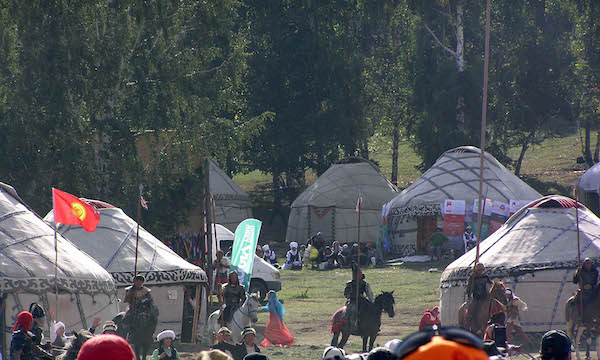
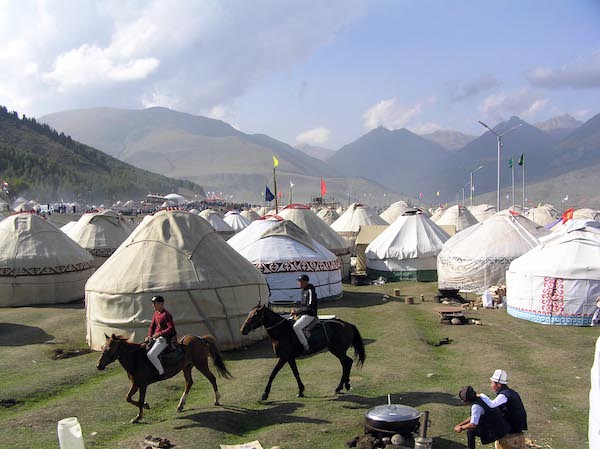
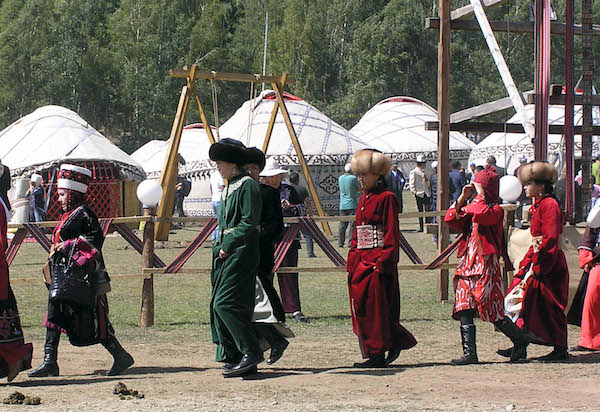
Day 11: A sad day. The only journeys I made were between the bedroom and the bathroom.
Day 12: Still feeling very rough, but determined not to miss everything. In the valley beyond the stadium was a vast yurt-city, yurts as far as the eye could see, selling everything from exquisite textiles to tourist drek probably made in Birmingham or China. Men wandered about on horseback; people carried eagles and falcons for photo-ops, or lead camels; many wore exotic headgear: Diane said it was like the Mississippi State Fair, only more so. It was how I imagined a medieval fair or pageant. I found it far more compelling than goat polo or watching sweaty hulks wrestling. I just strolled about, enjoying the ambience. In a great enclosure, men and women in fabulous costumes were performing some form of national epic, like some Kyrgyz version of the York Mystery plays of the Middle Ages. In another part of the valley, men on horseback in leather armour were wielding long lances at a quintain, a shield-shaped target set on a rotating arm mounted on a sturdy base. Women demonstrated carpet weaving and yurt-construction.
I spent little time in the stadium. The equestrian acrobats were incredibly skilful—Kyrgyz nomads can ride before they can walk—but archery is not a great spectator sport, like watching chess.
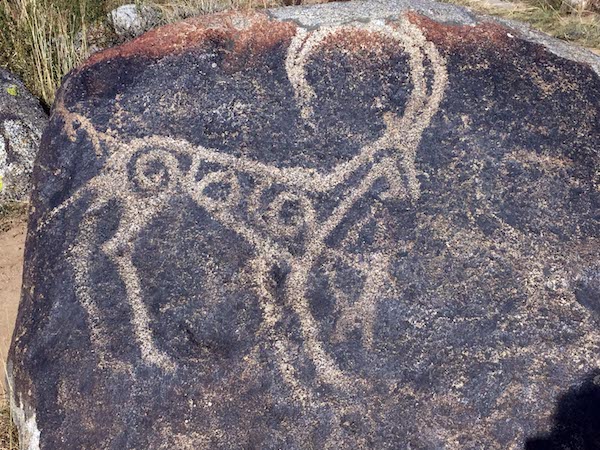
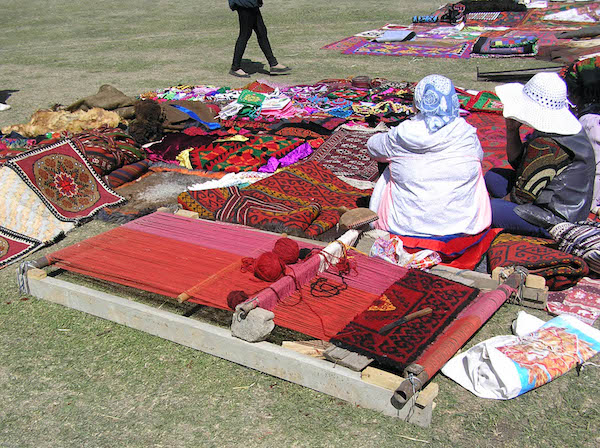
Day 13: The Games continued, but we left for Bishkek. En route, we stopped at a park full of rocks covered with petroglyphs created two millennia and more ago.
Our final dinner was at a superb restaurant in Bishkek called Navat. We were in a private room with our wonderful guides, Antonia and Valentina, and our brilliant drivers, Abe and Tofik. We were serenaded by a quartet singing and playing their national instruments: the komuz, a three-stringed guitar, the temir komuz, a droning mouth harp, and a drum whose name I didn’t catch. Very evocative and beautiful.
I cannot recommend Kyrgyzstan highly enough. The people are friendly and hospitable, delighted to see and entertain foreign visitors; and no photography can do justice to the majesty of the landscapes. Put it on your bucket list.
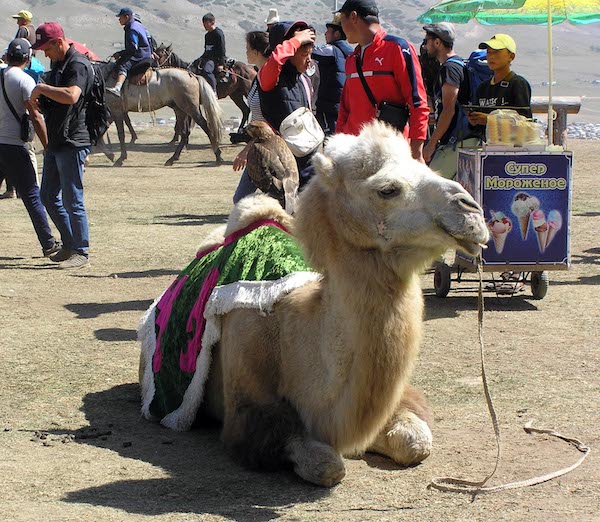
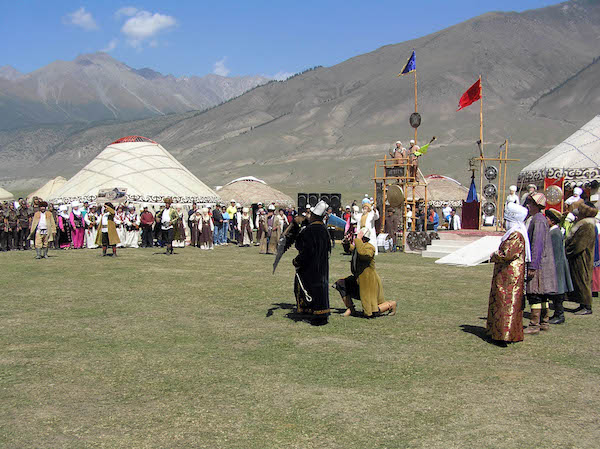
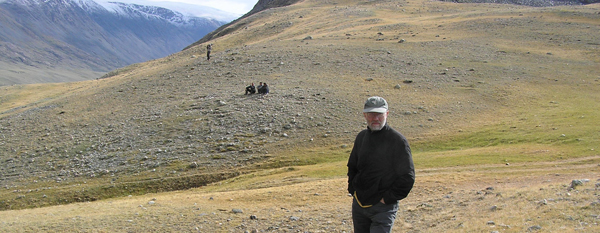
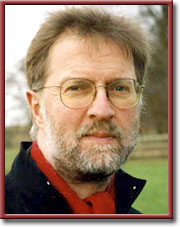
4 Comments
Anita Sullivan
Michael — What an exciting and delightful journey, and the photos are more than splendid! I just finished Roger Deakin’s account of his trip to Kyrgyzstan’s Fergana Valley, where the walnut originated, and where scads of apple varieties are also grown (apple tree originated in Kazakhstan) These high mountain valleys are a kind of paradise, and I hope they remain somewhat hidden from the madding crowds so their people can continue leading their traditional lives. Thanks for this fascinating piece.!
Michael House
Anita – thank you for you kind words. I think it is Diane’s photos that make the piece. It is always a dilemma in travel writing: if you find a wonderful place, do you keep it under your hat, or do you tell the world? I don’t think the country will be swamped by tourists, but it can certainly use more foreign currency. Behind the idyll is a good deal of poverty and deprivation. Low-key tourism, such as provided by the outfit I travelled with, Wild Frontiers of London, is a pretty good answer.
Jean
Michael, this is grand. In general, I am not much of a girl for travel pieces, but the illustrations and commentary, both informative and evocative, make your essay the exception. You now have me very curious about the Nomad games, the eagle hunters, and felt. I greatly enjoyed the manner in which you demonstrate that time travel may be possible, after all. Thanks!
Michael House
Jean, I’m glad you enjoyed it. The Games are held every two years, and I beleive they will be in Turkey in 2020, hence Erdogan’s presence at the opening ceremony. The eagles are taken from the nest when tiny, trained and used for some years, then I believe released into the wild. Felt is an amazingly versatile stuff, made by a simple if strenuous process, but it is their fabulous old embroideries that I like best. I will try to post a photo of the piece I bought. Thanks again.